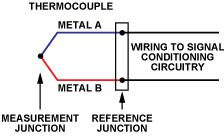
Thermocouple and Thermoresistor Fault Handling (Part 2)
2025-09-09 10:39
Common faults of thermocouples and thermal resistors
Fault Phenomenon | Possible Cause | Treatment Method |
| Thermoelectric potential lower than actual value (indicated value too low) | Thermocouple internal moisture | Dry protection tube and thermoelectrode, check cause of water leakage |
| Local short circuit of thermoelectrode or junction box | Remove thermoelectrode, check leakage cause | |
| Compensation wire not matching with thermocouple | Replace with matching compensation wire | |
| Thermoelectric potential higher than actual value (indicated value too high) | Thermocouple not matching with display instrument | Replace thermocouple or display instrument to match |
| Insulation damage causing external power entering thermocouple circuit | Check and remove interference source, repair or replace insulation materials | |
| Cold junction temperature too high | Adjust cold junction temperature or calibrate | |
| Thermoelectric potential unstable (indicated value fluctuates) | Poor contact at measuring terminal, intermittent connection | Clean terminals and thermoelectrode cold end, retighten |
| Thermocouple not firmly installed or vibration | Take anti-vibration measures, firmly fix thermocouple | |
| External interference | Check interference source, apply shielding or grounding | |
| No thermoelectric potential output (no instrument indication) | Measurement circuit short circuit | Find short circuit point, reconnect, replace insulation |
| Thermocouple circuit broken | Find broken point, reconnect | |
| Loose terminal | Tighten terminals |
Temperature Source Component Installation
The temperature source component should be installed in a location where the medium temperature changes sensitively, is representative, and easily observable. It should not be installed near resistance components such as valves, in dead zones in the medium flow, or in locations with high vibration.
Thermocouple source components should be installed away from strong magnetic fields. The installation of temperature source components on process pipelines should comply with the following regulations:
a) When installed perpendicular to the process pipeline, the axis of the source component should intersect perpendicularly with the axis of the process pipeline.
b) When installed at a bend in the process pipeline, the axis of the source component should be aligned with the axis of the process pipeline.
c) When installed at an angle to the process pipeline, the axis of the source component should be aligned with the axis of the process pipeline.
When the source component is installed on an expansion pipe, the expansion pipe diameter should be no less than 100mm.
The installation of the source component should be carried out simultaneously with pipeline prefabrication and installation. In particular, source components for corrosion-resistant and lined pipes and concrete casts within masonry structures should be pre-buried and reserved. Drilling and welding must be performed before corrosion protection, lining, and pressure testing of equipment or pipelines. When installing source components, drilling and welding should not occur on weld seams or their edges. Mechanical processing should be used when drilling holes in high-pressure, alloy steel, or nonferrous metal equipment and pipelines.
